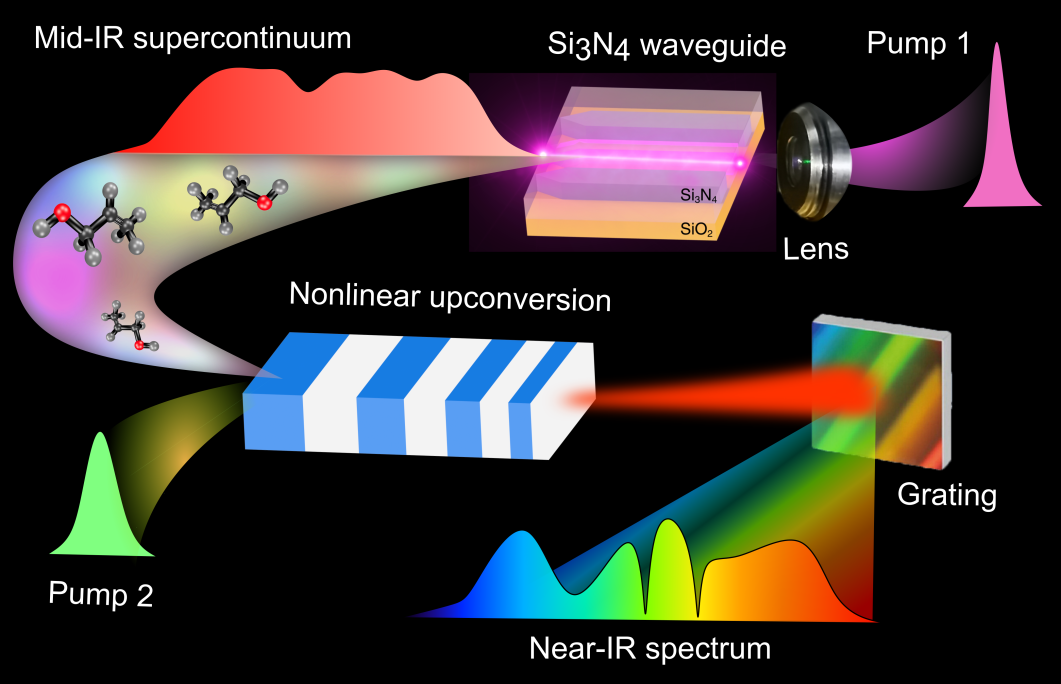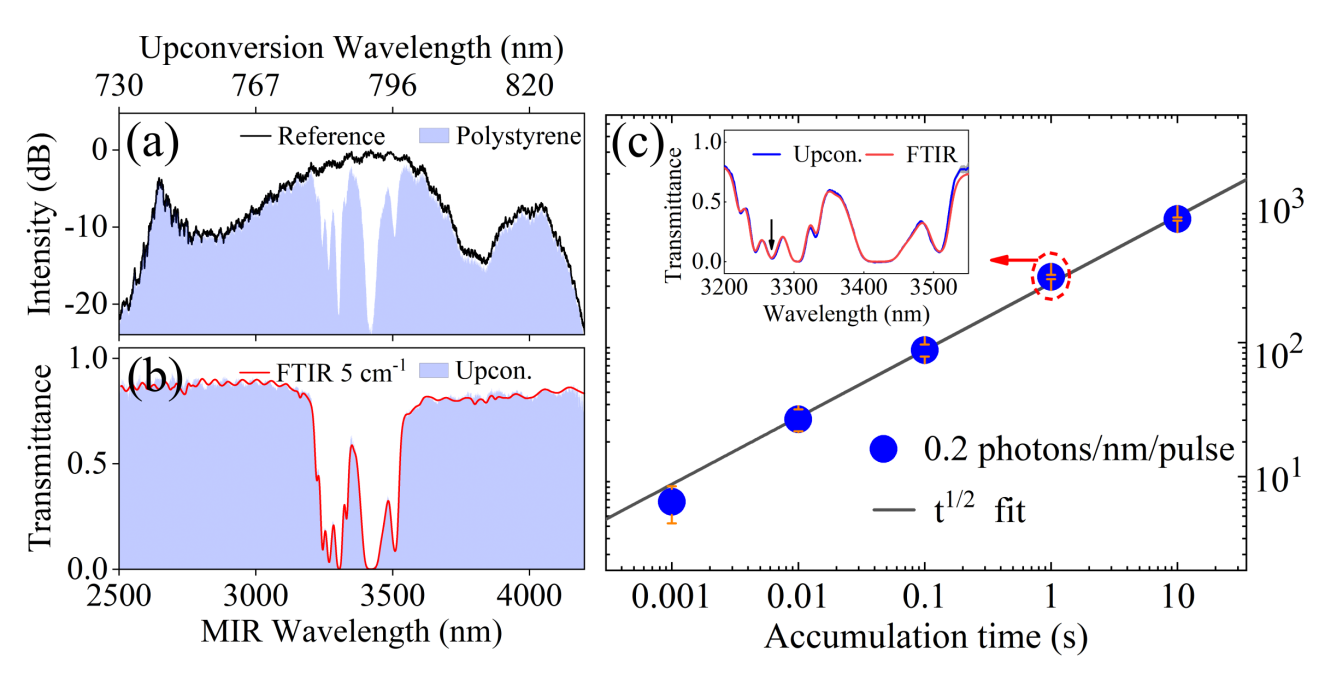Professor Zeng Heping and researcher Huang Kun of East China Normal University have made important progress in mid-infrared high-speed spectral detection, and developed a wide-band, ultra-sensitive, high-frame-frequency mid-infrared upconversion spectroscopic measurement technology, which has a single-photon detection sensitivity close to the quantum limit and a spectral refresh rate of nearly one million frames per second, and can provide support for high-speed sensitive mid-infrared spectral measurements required for combustion field analysis, high-throughput sorting and chemical reaction tracking applications. Infrared spectroscopic measurements for applications such as combustion field analysis, high throughput sorting and chemical reaction tracking. The related results were published online in Laser & Photonics Reviews on 9 May 2023 under the title "High-Speed Mid-Infrared Single-Photon Upconversion Spectrometer ".

Figure 1: Laser & Photonics Reviews published the latest research results of Heping Zeng's group.
The mid-infrared (MIR) band is the "fingerprint" spectral region of molecules, which contains the characteristic spectral lines of many molecular transitions. Highly sensitive and high speed mid-infrared (MIR) spectroscopy has important applications in astronomical observation, drug synthesis and environmental monitoring. However, the performance of traditional mid-infrared spectrometers is often limited by the detector sensitivity and the brightness of the broadband light source. Achieving high speed spectroscopic measurements in the mid-infrared with high signal-to-noise ratio has long been a research hotspot in the field of infrared spectroscopy.
In recent years, the frequency upconversion technique provides an effective solution for sensitive infrared detection. This technique converts the mid-infrared band to the visible or near-infrared band through a nonlinear process, and then realises sensitive signal capture using high-performance silicon-based detectors. Currently, achieving high conversion efficiency and low background noise over a wide spectral range is still challenging. To date, ultrasensitive mid-infrared spectroscopic measurements at the single-photon level have been limited to a narrow spectral range, with single measurements typically in the tens of nanometres band. In addition, the lower spectral brightness of upconversion spectrometers based on thermal radiation or parametric fluorescence as the illumination source makes the spectral detection rate limited. Therefore, the realisation of wide-band, ultra-sensitive, high-frame-frequency mid-infrared upconversion spectroscopy remains a challenge, and there is an urgent need to develop key technologies such as high-brightness mid-infrared light sources, high-efficiency frequency conversion, and low-noise photon detection.

Figure 2: Schematic diagram of the broadband mid-infrared single-photon upconversion spectrometer
To this end, the research team constructed a broadband mid-infrared upconversion spectrometer with single-photon detection sensitivity and sub-MHz refresh rate (Figure 2). In the preparation of the mid-infrared light source, a broadband mid-infrared supercontinuum light source covering 1.5-4.2 μm was prepared by using a silicon nitride ( Si3N4 ) photonic waveguide, which has better directionality, better beam quality, and higher spectral brightness compared with the traditional thermal radiation light source, and through the dispersion control of the waveguide structure and the time-frequency control of the pump light field, the spectral coverage and spectral flatness can be customised and optimised (Figure 3). The parameters such as spectral coverage and spectral flatness can be tailored and optimised through waveguide structure dispersion modulation and pump field time-frequency control (Figure 3). In addition, compared with the mid-infrared preparation based on solid-state optical parametric oscillators, the supercontinuum spectral source based on optical waveguide integration is directly compatible with fibre lasers, which provides an effective way for the development of a highly integrated and stable mid-infrared broadband coherent light source acquisition, and helps to improve the signal-to-noise ratio and refresh rate of the subsequent spectral measurements.

Figure 3: Mid-infrared supercontinuum spectrum generation based on silicon nitride photonic waveguide with spectral coverage of 1.5-4.2 μm.
In the mid-infrared spectral detection, the researchers have developed a nonlinear frequency upconversion detection technique with synchronous pulse pumping. By preparing pump pulses with high precision synchronization with the photonic time domain of the infrared signal, the researchers have realized the mid-infrared conversion with high efficiency in the chirp-polarized lithium niobate nonlinear crystal with an ultra-broad bandwidth of 1700 nm, and then realized the mid-infrared spectral measurements with high-resolution and high-sensitivity by means of high-performance visible/near-infrared spectroscopy and detector devices (Fig. 3). The high-resolution and high-sensitivity mid-infrared spectroscopic measurements were then achieved with high-performance visible/near-infrared spectroscopic and detector devices (Fig. 4). In order to further suppress the parametric fluorescence noise and ambient background noise, the researchers combined the efficient spatial filtering and spectral filtering techniques to obtain a noise suppression ratio as high as 210 dB, and ultimately obtained an ultra-sensitive mid-infrared spectrum of 0.2 photons/nm/pulse with a spectral resolution of 5 cm-1 by using a silicon-based EMCCD. Further, thanks to the high brightness of the broadband mid-infrared source, the efficient frequency conversion, and the noise filtering performance with high rejection ratio, the researchers achieved a spectral acquisition rate of up to 212,500 fps with the high-performance silicon-based CMOS camera, which is at least one order of magnitude higher than the previous reports at the same signal-to-noise ratio.

Figure 4: Wide-band mid-infrared upconversion spectrum with detection sensitivity of 0.2 photons/nm/pulse.
It is worth mentioning that the developed mid-infrared spectrometer utilises a silicon-based detection array and is capable of operating at room temperature, which contributes to its stable operation in practical applications. In future work, the straight waveguide can be replaced with a double-core silicon nitride waveguide to produce a flatter mid-infrared supercontinuum spectrum; by optimising the spectral width of the frequency-converted pump pulses and utilising the chirped-pulse nonlinear up-conversion technique, the spectral resolution of the system can be further improved; at the same time, by replacing the surface-array COMS camera with the line-array, the spectral acquisition rate is expected to increase to above MHz. The broadband spectral coverage, single-photon sensitivity and megahertz refresh rate of this spectrometer can provide strong support for infrared transient spectroscopic measurements in the fields of combustion field analysis, high-throughput sorting and reaction tracking.
This work was supported by Professor Hairun Guo's team at Shanghai University. The first author of the paper is PhD student Tingting Zheng, and the corresponding authors are researcher Kun Huang and Professor Hairun Guo.
In recent years, the group of Prof. Heping Zeng and Kun Huang has carried out a series of innovative researches in infrared photon nonlinear measurement and control, and successively developed mid-infrared single-photon upconversion imaging technology [Laser Photon. Rev. 15, 2100189 (2021)], mid-infrared nonlinear wide-angle imaging technology [Nature Commun. 13, 1077 ( 2022)], mid-infrared single-photon single-pixel imaging [Nature Commun. 14, 1073 (2023)], and so on. The related work was supported by grants from the Ministry of Science and Technology, Foundation Committee, Shanghai Science and Technology Commission, Chongqing Science and Technology Bureau and East China Normal University.
Link to the paper: High-Speed Mid-Infrared Single-Photon Upconversion Spectrometer
